Home → Fish & Wildlife → Wildlife → Species Information → Birds → Raptors → Falcons
Falcons

Falcons have highly tapered wings engineered for speed and maneuverability. Falconry is a centuries old means of hunting with raptors. A variety of species are used, but falcons are favored.
Three species of falcons now nest in Maine and are featured here. A fourth, the gyrfalcon, is a transient migrant and winter visitor.
American Kestrel
American kestrel (adult female) at nest box,
Aroostook County
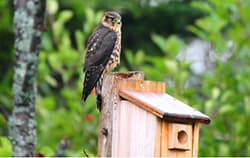
© Paul Cyr, Crown of Maine Photography
Maine's smallest falcon was once called the "sparrow hawk." The species lives only in the America's, but other species of kestrels occur elsewhere. It was traditionally a cavity nester in trees. American kestrels were once broadly seen perched on roadside utility wires or hovering over open lands. Their diet is mostly insects and small rodents.
A long, gradual decline is evident across most of the U.S. Reforestation of old farmland is working against kestrels in the Northeast. The American Kestrel Partnership is soliciting widespread installation and monitoring of nest boxes to bolster populations. The long trend of diminishing agricultural lands (partly to land development but more so to reforestation here in Maine) has certainly reduced suitable habitats.
Merlin
Merlin (juvenile plumage) in flight eating a dragonfly,
Knox County
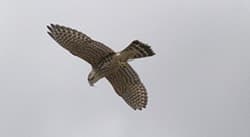
© Don Reimer
Larger than American kestrels, this small falcon inhabits northern forestlands of North America, Europe, and Asia. It was once popularly called the "pigeon hawk." In the Northeast, increasing numbers and a southward range expansion are evident. Historic nesting in Maine is uncertain. However, it is now a widespread breeding bird across most of Maine, although never abundant in any region.
Since the late-1970s, merlin nests are increasingly encountered across Maine in varied settings ranging from offshore coastal islands to northern interior forests and mountains. They do not build a stick nest but use others built by crows and hawks. Small birds dominate their diet, but merlins are ambitious raptors that may tackle sandpipers, blue jays, and similar birds nearly its own size. The abundance of merlins across Maine peaks during the fall migration as large numbers from Canada head southward.
Peregrine Falcon
Peregrine falcon (adult), Knox County
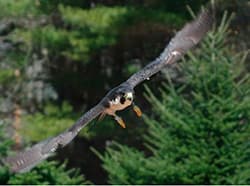
© Terry Heitz, Avian Haven Wildlife Rehabilitation Clinic
Celebrated as the fastest bird in the world, the dramatic "stoop" (a high speed dive with wings folded) enables a peregrine to reach speeds of 200 miles / hour! Long, narrow wings promote speed and agility. A small bony tubercle in the opening of each nostril helps deflect excessive air from overfilling its lungs. In a sustained stoop, the peregrine can streamline its shape even more by slightly dislocating the shoulder joints of its wings.
Its breeding range spans most land areas except extreme polar regions, but peregrines were once threatened globally. Biologists recognize between 17 and 19 subspecies specialized for variable conditions from the arctic tundra to the tropics. The "American peregrine" was the subspecies that traditionally nested in Maine, while the "tundra peregrine" passes quickly through the state during fall migrations.
Identification
Peregrines are similar to a crow in overall size. Reversed dimorphism of the sexes is more pronounced than in most raptors; females are 20 – 30% larger than males. Head feathering is highly distinctive: a dark crown and a "mustache" stripe give the appearance of a helmet. Adult peregrines are slate gray above, but white – buffy colored underneath with fine, dark barring. (The horizontal bars are more conspicuous on breasts of females than male peregrines.) The plumage of the sexes is otherwise similar.
Juvenile peregrines have dark brown backs and wings slightly contrasting a sandy-colored breast that is heavily marked with dark streaking (vertical markings). In the second year of life, the "subadult" plumage is often a blend of gray / brown on the back of the bird, and the underside may be a mix of bars and streaks depending on the stage of feather molt. The adult plumage is fully attained after the second annual molt.
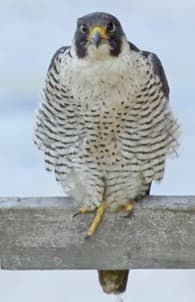
© Sharon Fiedler
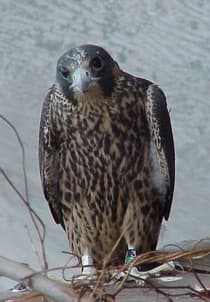
© Rob Becker, U.S. Navy
Status
Abandoned peregrine eyrie, Oxford County
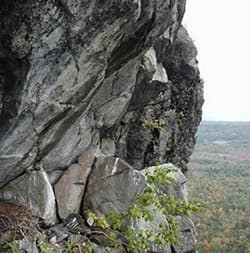
© Leslie Rowse, U.S. Forest Service
Breeding populations of peregrines in the continental U.S. were first listed as "Endangered" under federal law in 1970. Widespread improvements followed decades of intensive recovery programs, and federal delisting occurred in 1999. Many eastern states and provinces continue special protection status for peregrines. The resident breeding population of peregrines remains "Endangered" under Maine's Endangered Species Act.
Transient tundra peregrines pass through Maine in considerable numbers during fall migration. They mostly nest in Greenland, arctic Canada, and northern Alaska. They are no longer given special status in the Maine.
Nesting peregrines disappeared from the eastern U.S. by the early 1960s. The habitat remained suitable, but DDE (a by-product of the insecticide DDT) and other human influences impaired nesting falcons.
Cliffs where peregrines made a simple "scrape" in gravel substrate on ledges as a nest or used a remnant stick nest (often built by ravens) were abandoned. Ravens and other raptors occupied dramatic cliffs once ruled by peregrines or golden eagles. Long white streaks on a cliff or building sometimes serve as evidence of peregrine use.
Conservation
Active restoration of the peregrine falcon occurred in more than 35 nations. Captive breeding programs provided young falcons for reintroduction at suitable locations via "hacking." This is a variation of a traditional falconry practice where birds are gradually returned to the wild. Young peregrines were acclimated in a protective box on the edge of cliffs until ∼ 6 weeks of age, the normal age for first flights. A long food chute enabled attendants to feed them without promoting connections to human caretakers. A total of 153 young peregrines were reintroduced to Maine during 1984 – 1997. Whether hacked or reared by adults, juvenile peregrines generally disperse after 5 – 7 weeks on the wing following fledging.
Reintroduction "hack" site, Franklin County
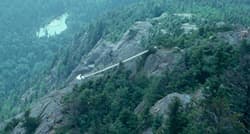
© Charlie Todd, MDIFW
The first re-established pair of nesting peregrines was found in Piscataquis County in 1987 = 25 years after the demise of Maine's former breeding population. Since 1988, wild peregrines have yielded increasing numbers of young falcons to bolster their comeback.
In order to avoid disturbing falcons, some cliffs or hiking trails very close to a cliff may be seasonally closed to recreational use. Acadia National Park, White Mountains National Forest, and the Maine Bureau of Parks and Lands are key cooperators of peregrine recovery in the state.
Research updates
Banding young peregrines, Cumberland County
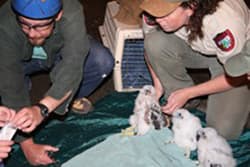
© Doug Rafferty, MDIFW
Nicole Munkwitz climbing into a peregrine nest,
Washington County
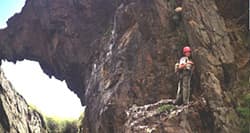
© Charlie Todd, MDIFW
Young peregrines can be safely banded at about 3 weeks of age by teams of skilled climbers and biologists. Biologists also collect feather samples, blood samples and addled eggs to gauge exposure to contaminants. Bird bands generate information about movements and survival rates.
Since peregrines remain relatively rare in the East, biologists need to understand the interchange of birds between neighboring states and provinces. Peregrines originally banded in Maine have been identified as breeding birds in New Brunswick, New Hampshire, Vermont, Massachusetts, New York, and Virginia. The species name "pergrinus" literally translates as "wanderer."
Birding enthusiasts and photographers have aided such studies by sharing encounters of banded peregrines. Please continue to do so and report locations of suspected nesting activity. Peregrines are most visible during the courtship period before egg-laying (generally during March in Maine). They are relatively hard to see during a month long incubation period. If eggs hatch, food deliveries to nestlings and the general turmoil of fledglings on-the-wing increase their visibility during June and July. Look for distinctive color bands with color combinations and letter and / or number codes unique to that individual. A bird band rests loosely on the lower leg above the ankle joint.
Banded adult peregrine, Cumberland County
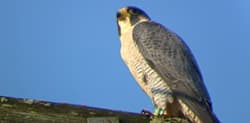
© Lysle Brinker